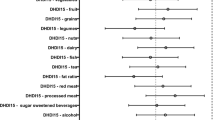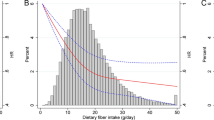Abstract
Purpose
Dietary fiber is a possible nutritional component which aids in the prevention of visceral fat accumulation. We examined the association between dietary fiber intake and visceral fat volume (VFV) by sex, and further analysed the association by major food sources of dietary fiber.
Methods
In this cross-sectional study, we measured VFV in 2779 Japanese (1564 men and 1215 women) aged 40–89 who underwent positron emission tomography/computed tomography for cancer screening between 2004 and 2005. Dietary fiber intake was calculated based on a validated semi-quantitative food frequency questionnaire. The association between dietary fiber intake and VFV was investigated using multivariate linear regression models after adjustment for potential confounders.
Results
Total, soluble, and insoluble fiber intakes were inversely associated with VFV in men (Q1: 3740 cm3, Q4: 3517 cm3, Ptrend: 0.0006 for total fiber), but not in women (Q1: 2207 cm3, Q4: 2193 cm3,Ptrend: 0.88 for total fiber). Statistically significant sex difference was observed (Pinteraction = 0.001 for total fiber). Subgroup analyses by major food sources revealed that dietary fiber intakes from beans, vegetables and fruits showed an inverse association with VFV in men, while cereal fiber intake showed a tendency toward a positive association in both sexes (Q1: 3520 cm3, Q4: 3671 cm3, Ptrend: 0.05 in men, Q1: 2147 cm3, Q4: 2227 cm3, Ptrend: 0.10 in women).
Conclusion
We observed a sex-specific association between dietary fiber intake and VFV in Japanese adults. This study suggests that efforts against visceral fat accumulation should take account of the source of dietary fiber.
Similar content being viewed by others
Data availability
Data described in the manuscript, code book, and analytic code will be made available upon request pending application and approval.
Abbreviations
- VFV:
-
visceral fat volume
- SCFAs:
-
short-chain fatty acids
- BMI:
-
body mass index
- JaSCo:
-
Japan-Screening Cohort
References
Silveira EA, Kliemann N, Noll M, Sarrafzadegan N, de Oliveira C (2021) Visceral obesity and incident cancer and cardiovascular disease: an integrative review of the epidemiological evidence. Obes Rev 22:e13088. https://doi.org/10.1111/obr.13088
Neeland IJ, Turer AT, Ayers CR, Powell-Wiley TM, Vega GL, Farzaneh-Far R et al (2012) Dysfunctional adiposity and the risk of Prediabetes and Type 2 diabetes in obese adults. JAMA 308:1150–1159. https://doi.org/10.1001/2012.jama.11132
Vaughn AC, Cooper EM, DiLorenzo PM, O’Loughlin LJ, Konkel ME, Peters JH et al (2017) Energy-dense diet triggers changes in gut microbiota, reorganization of gut-brain vagal communication and increases body fat accumulation. Acta Neurobiol Exp 77:18–30. https://doi.org/10.21307/ane-2017-033
Lambert JE, Parnell JA, Tunnicliffe JM, Han J, Sturzenegger T, Reimer RA (2017) Consuming yellow pea fiber reduces voluntary energy intake and body fat in overweight/obese adults in a 12-week randomized controlled trial. Clin Nutr 36:126–133. https://doi.org/10.1016/j.clnu.2015.12.016
Shimizu C, Kihara M, Aoe S, Araki S, Ito K, Hayashi K et al (2008) Effect of high β-glucan barley on serum cholesterol concentrations and visceral fat area in Japanese men—a randomized, double-blinded, placebo-controlled trial. Plant Foods Hum Nutr 63:21–25. https://doi.org/10.1007/s11130-007-0064-6
Wang S, Moustaid-Moussa N, Chen L, Mo H, Shastri A, Su R et al (2014) Novel insights of dietary polyphenols and obesity. J Nutri Biochem 25:1–18. https://doi.org/10.1016/j.jnutbio.2013.09.001
Franco BM, Latre ML, Esteban EMA, Ordov ás JM, Casasnovas JA, Peñalvo JL (2014) Soluble and insoluble dietary fiber intake and risk factors for metabolic syndrome and cardiovascular disease in middle-aged adults: the AWHS cohort. Nutr Hosp 30:1279–1288. https://doi.org/10.3305/nh.2014.30.6.7778
Du H, Van Der ADL, Boshuizen HC, Forouhi NG, Wareham NJ, Halkjær J et al (2010) Dietary fiber and subsequent changes in body weight and waist circumference in European men and women. Am J Clin Nutr 91:329–336. https://doi.org/10.3945/ajcn.2009.28191
Veldhuis L, Koppes LLJ, Driessen MT, Samoocha D, Twisk JWR (2010) Effects of dietary fibre intake during adolescence on the components of the metabolic syndrome at the age of 36 years: the Amsterdam Growth and Health Longitudinal Study. J Hum Nutr Diet 23:601–608. https://doi.org/10.1111/j.1365-277X.2010.01089.x
Ozato N, Saito S, Yamaguchi T, Katashima M, Tokuda I, Sawada K et al (2019) Association between nutrients and visceral fat in healthy Japanese adults: a 2-year longitudinal study brief title: micronutrients associated with visceral fat accumulation. Nutrients 7:11:2698. https://doi.org/10.3390/nu11112698
Ben Slama F, Jebali N, Chemli R, Ben Rayana C, Achour A, Najar MF et al (2011) Dietary fiber in the diets of urban Tunisian women: Association of fiber intake with BMI, waist circumference and blood chemistry: preliminary study. Clin Res Hepatol Gastroenterol 35:750–754. https://doi.org/10.1016/j.clinre.2011.04.005
Sekgala MD, McHiza ZJ, Parker WA, Monyeki KD (2018) Dietary fiber intake and metabolic syndrome risk factors among young South African adults. Nutrients 10:504. https://doi.org/10.3390/nu10040504
Lairon D, Arnault N, Bertrais S, Planells R, Clero E, Hercberg S et al (2005) Dietary fiber intake and risk factors for cardiovascular disease in French adults. Am J Clin Nutr 82:1185–1194. https://doi.org/10.1093/ajcn/82.6.1185
Ludwig DS, Pereira MA, Kroenke CH, Hilner JE, Linda RD, Horn V et al (1999) Dietary Fiber, Weight Gain, and Cardiovascular Disease Risk Factors in Young Adults. JAMA 282:1539–1546. https://doi.org/10.1001/jama.282.16.1539
Zhou Q, Wu J, Tang J, Wang JJ, Lu CH, Wang PX (2015) Beneficial effect of higher dietary fiber intake on plasma HDL-C and TC/HDL-C ratio among Chinese rural-to-urban migrant workers. Int J Environ Res Public Health 12:4726–4738. https://doi.org/10.3390/ijerph120504726
Palmer BF, Clegg DJ (2015) The sexual dimorphism of obesity. Mol Cell Endocrinol 402:113–119. https://doi.org/10.1016/j.mce.2014.11.029
Karastergiou K, Smith SR, Greenberg AS, Fried SK (2012) Sex differences in human adipose tissues - the biology of pear shape. Biol Sex Differ 3:13. https://doi.org/10.1186/2042-6410-3-13
Takachi R, Ishihara J, Iwasaki M, Hosoi S, Ishii Y, Sasazuki S et al (2011) Validity of a self-administered food frequency questionnaire for middle-aged urban cancer screenees: comparison with 4-day weighed dietary records. J Epidemiol 21:447–458. https://doi.org/10.2188/jea.je20100173
The National Health and Nutrition Survey in Japan Ministry of Health, Labour and Welfare Publishing Web.https://www.mhlw.go.jp/content/000711006.pdf Accessed 17 November 2023
Yamaji T, Iwasaki M, Sasazuki S, Sakamoto H, Yoshida T, Tsugane S (2012) Association between plasma 25-hydroxyvitamin D and colorectal adenoma according to dietary calcium intake and vitamin D receptor polymorphism. Am J Epidemiol 175:236–244. https://doi.org/10.1093/aje/kwr295
Yamaji T, Iwasaki M, Sasazuki S, Sakamoto H, Yoshida T, Tsugane S (2009) Methionine synthase A2756G polymorphism interacts with alcohol and folate intake to influence the risk of colorectal adenoma. Cancer Epidemiol Biomarkers Prev 18:267–274. https://doi.org/10.1158/1055-9965.EPI-08-0702
Yamaji T, Iwasaki M, Sasazuki S, Tsugane S (2010) Interaction between adiponectin and leptin influences the risk of colorectal adenoma. Cancer Res 70:5430–5437. https://doi.org/10.1158/0008-5472.CAN-10-0178
Standard Tables of Food Composition in Japan The Seventh Revised Version 2015. Ministry of Education Culture, Sports, Science and Technology-Japan (MEXT) Publishing Web http://www.mext.go.jp/en/policy/science_technology/policy/title01/detail01/1374030.htm Accessed 17 November 2023
Willett WC, Howe GR, Kushi LH (1997) Adjustment for total energy intake in epidemiologic studies. Am J Clin Nutr 65:1220S–1228S. https://doi.org/10.1093/ajcn/65.4.1220S
Kikuchi H, Inoue S, Odagiri Y, Ihira H, Inoue M, Sawada N et al (2020) Intensity-specific validity and reliability of the Japan Public Health Center-based prospective study-physical activity questionnaire. Prev Med Rep 20:101–169. https://doi.org/10.1016/j.pmedr.2020.101169
Yamaji T, Iwasaki M, Sasazuki S, Kurahashi N, Mutoh M, Yamamoto S et al (2009) Visceral fat volume and the prevalence of colorectal adenoma. Am J Epidemiol 170:1502–1511. https://doi.org/10.1093/aje/kwp311
Watanabe T, Kobayashi S, Yamaguchi T, Hibi M, Fukuhara I, Osaki N (2019) Coffee abundant in chlorogenic acids reduces abdominal fat in overweight adults: a randomized, double-blind, controlled trial. Nutrients 11:1617. https://doi.org/10.3390/nu11071617
Maki KC, Reeves MS, Farmer M, Yasunaga K, Matsuo N, Katsuragi Y et al (2009) Green tea catechin consumption enhances exercise-induced abdominal fat loss in overweight and obese adults. J Nutri 139:264–270. https://doi.org/10.3945/jn.108.098293
Yamaji T, Iwasaki M, Sasazuki S, Tsugane S (2012) Gender difference in the association of insulin and the insulin-like growth factor axis with colorectal neoplasia. Int J Obes 36:440–447. https://doi.org/10.1038/ijo.2011.114
World Health Organization Waist circumference and waist-hip ratio: report of a WHO expert consultation, Geneva, 8–11 December 2008
Kimura I, Ozawa K, Inoue D, Imamura T, Kimura K, Maeda T et al (2013) The gut microbiota suppresses insulin-mediated fat accumulation via the short-chain fatty acid receptor GPR43. Nat Commun 4:1829. https://doi.org/10.1038/ncomms2852
Chakraborti CK (2015) New-found link between microbiota and obesity. World J Gastrointest Pathophysiol 6:110–119. https://doi.org/10.4291/wjgp.v6.i4.110
Chambers ES, Viardot A, Psichas A, Morrison DJ, Murphy KG, Zac-Varghese et al (2015) Effects of targeted delivery of propionate to the human colon on appetite regulation, body weight maintenance and adiposity in overweight adults. Gut 64:1744–1754. https://doi.org/10.1136/gutjnl-2014-307913
Kondo T, Kishi M, Fushimi T, Ugajin S, Kaga T (2009) Vinegar intake reduces body weight, body fat mass, and serum triglyceride levels in obese Japanese subjects. Biosci Biotechnol Biochem 73:1837–1843. https://doi.org/10.1271/bbb.90231
Ozato N, Saito S, Yamaguchi T, Katashima M, Tokuda I, Sawada K et al (2019) Blautia genus associated with visceral fat accumulation in adults 20–76 years of age. NPJ Biofilms Microbiomes 5:28. https://doi.org/10.1038/s41522-019-0101-x
Takagi T, Naito Y, Inoue R, Kashiwagi S, Uchiyama K, Mizushima K et al (2019) Differences in gut microbiota associated with age, sex, and stool consistency in healthy Japanese subjects. J Gastroenterol 54:53–63. https://doi.org/10.1007/s00535-018-1488-5
Koliada A, Moseiko V, Romanenko M, Lushchak O, Kryzhanovska N, Guryanov V et al (2021) Sex differences in the phylum-level human gut microbiota composition. BMC Microbiol 21:131. https://doi.org/10.1186/s12866-021-02198-y
Tsukiyama H, Nagai Y, Matsubara F, Shimizu H, Iwamoto T, Yamanouchi E et al (2016) Proposed cut-off values of the waist circumference for metabolic syndrome based on visceral fat volume in a Japanese population. J Diabetes Investig 7:587–593. https://doi.org/10.1111/jdi.12454
Author information
Authors and Affiliations
Contributions
Maki Igarashi and Taiki Yamaji wrote the manuscript and Motoki Iwasaki, Ryoko Katagiri, Shoichiro Tsugane, and Nozomu Kobayashi revised the manuscript. Maki Igarashi and Taiki Yamaji performed the statistical analysis. Taiki Yamaji designed the project. All authors have read and agreed to the published version of the manuscript.
Corresponding author
Ethics declarations
Conflict of interest
Maki Igarashi, Motoki Iwasaki, Ryoko Katagiri, Shoichiro Tsugane, Nozomu Kobayashi, and Taiki Yamaji report that they have no conflicts of interest. The authors declare that they have no known competing financial interests or personal relationships that could have appeared to influence the work reported in this paper.
Sources of support for the work
The National Cancer Center Japan-Screening Cohort (JaSCo) Study was supported by the National Cancer Center Research and Development Fund (23-A-1, 26-A-1, 29-A-1, 2020-J-1, and 2023-J-1), and Ministry of Health, Labour, and Welfare of Japan (Grants-in-Aid for Cancer Research 17 - 1, Grants-in-Aid for the Third Term Comprehensive 10-Year Strategy for Cancer Control).
Electronic supplementary material
Below is the link to the electronic supplementary material.
Rights and permissions
Springer Nature or its licensor (e.g. a society or other partner) holds exclusive rights to this article under a publishing agreement with the author(s) or other rightsholder(s); author self-archiving of the accepted manuscript version of this article is solely governed by the terms of such publishing agreement and applicable law.
About this article
Cite this article
Igarashi, M., Iwasaki, M., Katagiri, R. et al. Sex difference in the association of dietary fiber intake with visceral fat volume in Japanese adults. Eur J Nutr (2024). https://doi.org/10.1007/s00394-024-03405-y
Received:
Accepted:
Published:
DOI: https://doi.org/10.1007/s00394-024-03405-y




